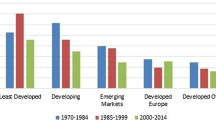Abstract
Studies show that the relationship between openness and output volatility is theoretically ambiguous, but most of these studies provide an empirical estimation for this relationship. This paper investigates the impact of trade openness on output volatility, and how this impact may be affected by the country’s level of development. We use a panel dataset for 33 countries for the years of 1980 through 2009. A standard deviation of quarterly real GDP over a 5-year span is used as the dependent variable. Controlling for the country and period-specific effects, the main results are as follows: trade openness increases the output volatility. And, the output volatility of countries with a higher level of development is less affected by trade openness.
Similar content being viewed by others
Notes
See UNDP 2014 Human Development Report.
\(\hbox {Log}(\hbox {RGDP}_{ it})=\hbox {Log}(\frac{\hbox {GDP}_{ it}}{\hbox {CPI}_{ it}})\), where \(\hbox {CPI}_{it}\) is the Consumer Price Index for country \(i\) in time \(t\).
Total PPP Converted GDP, G-K method, at current prices (in millions $).
Since \(t\) represents a period of 5 years and the openness is given by annual data, first, we take the logs of openness, and then, we calculate the average of logs over 5 years, that is, the average of the logs, not the log of the averages.
Note that the interaction term here is a continuous variable.
References
Bekaert G, Harvey C, Lundblad C (2006) Growth volatility and financial liberalization. J Int Money Finance 25(3):370–403
Calderón C, Schmidt-Hebbel K (2008) Openness and growth volatility. Working Paper No. 483, Central Bank of Chile
Giovanni J, Levchenko A (2009) Trade openness and volatility. Rev Econ Stat 91(3):558–585
Karras G (2006) Trade openness, economic size, and macroeconomic volatility: theory and empirical evidence. J Econ Integr 21(2):254–272
Smith LV, Galesi A (2011) GVAR Toolbox 1.1. http://www.cfap.jbs.cam.ac.uk/research/gvartoolbox
Yanikkaya H (2003) Trade openness and economic growth: a cross-country empirical investigation. J Dev Econ 72(1):57–89
Author information
Authors and Affiliations
Corresponding author
Rights and permissions
About this article
Cite this article
Abubaker, R. The asymmetric impact of trade openness on output volatility. Empir Econ 49, 881–887 (2015). https://doi.org/10.1007/s00181-014-0899-2
Received:
Accepted:
Published:
Issue Date:
DOI: https://doi.org/10.1007/s00181-014-0899-2




